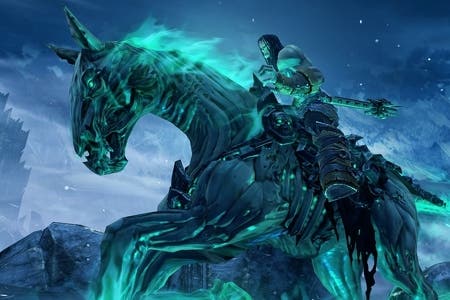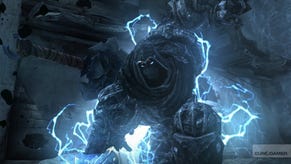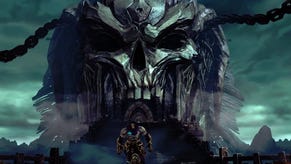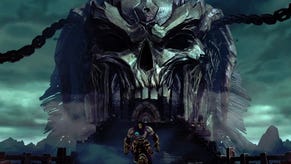Face-Off: Darksiders 2
Armageddon which version again?
| - | Xbox 360 | PlayStation 3 |
|---|---|---|
| Disc Size | 7.3GB | 7.74GB |
| Install | 7.3GB (optional) | - |
| Surround Support | Dolby Digital | Dolby Digital, DTS, 5.1LPCM |
Two years on from the launch of the original game, it's fair to say that Darksiders 2 doesn't quite feel as fresh or inspired as the original. Clearly borrowing heavily from God of War, Prince of Persia and the Legend of Zelda, Darksiders 2 feels like a mix of existing, familiar ideas and proves short on surprises. But despite this, the experience is still an enjoyable one: the combat has been refined over the first game, the world is much larger in size, and the quality of the narrative is impressive.
Vigil Games also deserve kudos for the uniform quality of the console offerings: Darksiders 2 is a very closely matched affair on all formats, with very few differences to separate the Xbox 360 and PlayStation 3 versions. Unfortunately, the developer has extended this philosophy to the PC version too, resulting in a title that is going to be quickly dismissed as a barebones console port - but more on that later.
To begin with, let's focus on the console games with our 720p head-to-head video, accompanied by a triple-format comparison gallery.
Similar to its predecessor, Darksiders 2 renders at a sub-HD resolution, coming in at 1152x640 on both platforms. However, whereas the original runs without any anti-aliasing, edge-smoothing has been applied in this sequel using what looks like a simple edge-detect/blur filter. The tech only affects a few pixels next to select edges, so is fairly non-destructive and hides some of the more glaring upscaling artifacts, though in places it does let some jaggies through. That said, the set-up Vigil Games has employed manages to work reasonably well with the style of the artwork and as a result we never really get the feeling that the lower-resolution frame-buffer, or lack of any proper anti-aliasing, compromises image integrity to any negative extent.
Beyond the core framebuffer set-up, Vigil Games has done an excellent job in achieving platform parity between all three versions of Darksiders 2, with only very minor differences. In the case of the consoles, for the most part the core artwork and effects are basically a match. Likewise LOD (level of detail) streaming appears to be identical, as does shadow quality and texture filtering. In terms of the latter, both versions utilise a very low level of anisotropic filtering which leaves ground textures looking very blurry in the distance, with a similarly lacklustre effect on other surfaces when viewed from extreme angles.
Where there are differences, they are fairly subtle and shouldn't impact on your enjoyment of the game in any way. Curiously, on the PS3 some areas feature higher-resolution textures compared to the Xbox 360 game; these surfaces contain more fine detail, with the additional intricacies improving the look of some scenes. The Xbox 360 appears to have charms of its own, however, with additional lighting effects enhancing the look of fire, explosions and contact flashes in various scenes. In particular, the heated pools of liquid metal in the furnace give off a fiery hot glow absent on the PS3. Elsewhere, there is a shadow off-set bias at work, where these elements protrude a little more outward on the 360 in some areas, and the difference in gamma set-up also creates a slightly darker-looking image on the PS3.
"The two console versions are mostly the same, but the Xbox 360 features additional lighting effects, while in some areas the PS3 game has higher-quality textures. PC offers the best of both worlds."
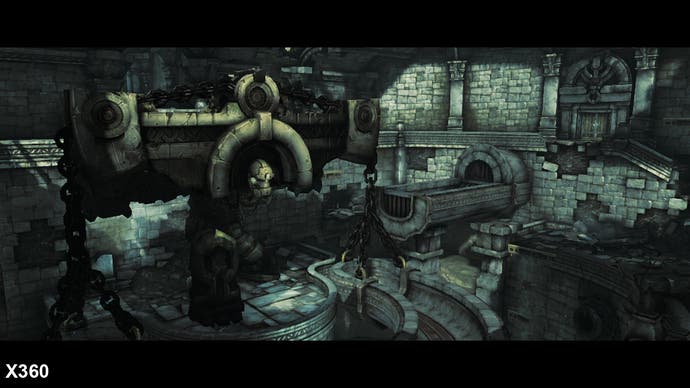


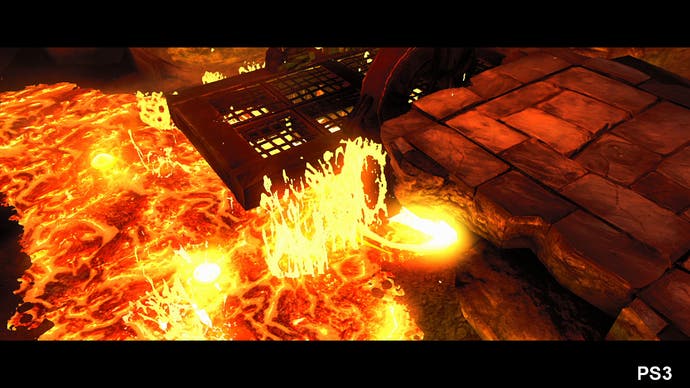
Beyond multi-platform differences, Darksiders 2 features a number of tech improvements over the first game. For one, all of the core cinematics are rendered using the in-game engine in real-time, with FMV sequences being reserved for the opening prologue and introductions for each chapter throughout the game. Video sequences are seemingly identical on both formats this time around, with neither format getting an advantage when it comes down to the quality of the encode. The stylised nature of these scenes also helps to conceal some of the blocking artifacts visible from the low-quality compression scheme used.
Secondly, the world in this new title is around three times as large as the one found in the first game, with each of the three hub areas being similar in size to the entire map found in the original Darksiders. It's an impressive achievement, with the landscape containing some epic areas, dominated by some large-scale structures and interestingly designed architecture. However, there are a lot of barren areas in which the art design and quality of the texture work take a hit, suggesting that, in creating such an expansive world, the design flair seen in key areas is simply spread a little bit too thinly throughout the entire game.
At the same time, all these different sections do come together to form a somewhat natural setting for the world to inhabit; from the plains at the beginning to the charred forest leading up to the Creator's Forge, along with the various dungeons spread throughout the different areas of the game. Additionally, while the lack of a real-time day/night cycle might come as a disappointing to some, the controlled nature of the game's lighting solution (using a combination of dynamic and pre-baked approaches) allows for the developers to set a particular tone and atmosphere unique to each area shaped by the game's narrative and focused direction, rather than by randomised events.
"Noteworthy differences are few and far between on the console games, though the Xbox 360 version has a noticeable loading time advantage, which grows still further when installed to hard drive."
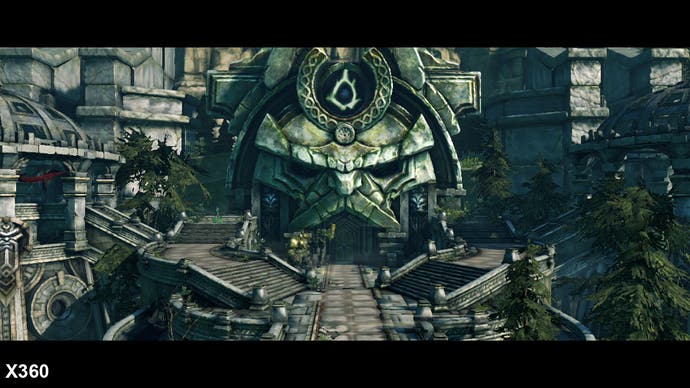

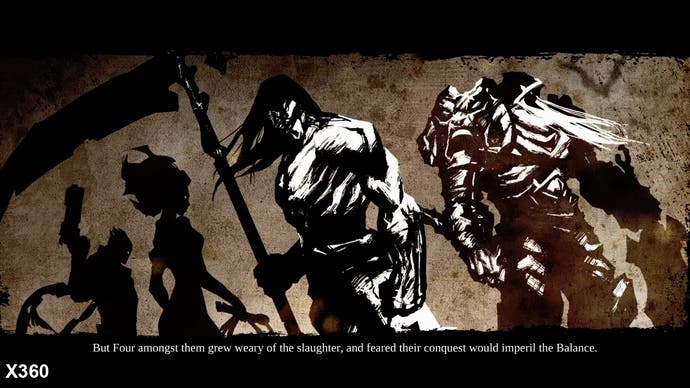
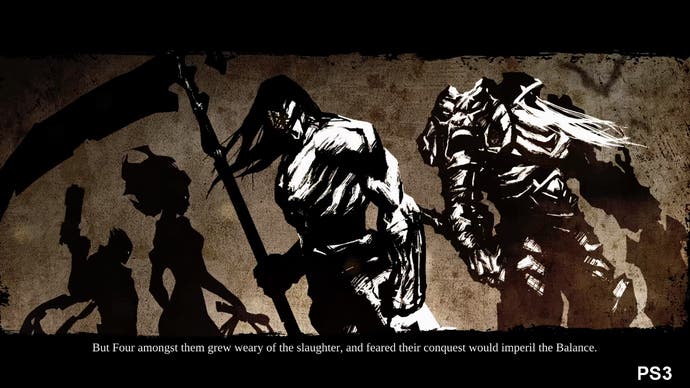
Overall, the two console versions of Darksiders 2 remain very close indeed, although it should be pointed out that there are some loading time differences, which is relevant as gameplay can pause momentarily while assets are loaded in. In this respect, the 360 has the advantage. We tested a specific gameplay pause and found it lasted six seconds on PS3, four seconds on 360 (running from disc) and just two seconds from an HDD install. Loading into gameplay from the main menu, there wasn't much different between the Xbox 360 and PS3 running from disc (21 vs. 23 seconds), but once again the HDD install won out, with the same section loading in just 14 seconds. The PS3 version has no mandatory or optional hard drive support.
Darksiders 2: Performance Analysis
As you would expect, the varied nature of the world also has an impact on performance, with more complex areas causing frame-rates to drop and heavy screen-tearing to manifest on both formats, although a smooth 30 frames per second update is present throughout much of the game when the engine isn't being pushed too hard. Basically, Darksiders 2 takes the usual approach seen in many current-generation titles of capping at 30FPS and allowing the game to tear when the engine cannot keep up with the rendering load. The idea here is that torn frames have less of an impact on controller response than a reduction in frame-rate, although in an ideal scenario we'd obviously rather have neither.
"Both console versions target 30 frames per second, dropping v-sync should performance dip below that level, resulting in noticeable screen-tear."
Across a general run of play it's clear that both versions perform very similarly throughout a variety of different scenes. For example, when traversing the environments via horseback, dips in frame-rate and screen-tearing appear at similar points on both consoles, with dense forest areas and scenes with detailed open areas causing some obvious issues. The initially smooth 30FPS is compromised with a juddering effect which impacts controls (they feel noticeably more laggy) while shattering image consistency.
Similarly, both consoles run into the same issues during combat when the engine is stressed, with plenty of dropped frames and screen-tearing impacting on the fluidity of the action, especially evident on effects-heavy boss attacks. Fighting a large group of enemies in enclosed spaces causes similar problems.
That said, the engine holds up very well in some of the other demanding boss battles, in which a number of enemies (along with the main foe) fill the screen with a number of particle and alpha effects, along with additional light sources on both platforms.
Darksiders 2's heavy use of engine-driven cut-scenes gives us plenty of material to see how the engine on both consoles copes when rendering the exact same content, and while the overall effect is mostly identical, there is a very small PS3 advantage in terms of fewer torn frames.
"Both consoles run into the same issues during combat when the engine is stressed, with plenty of dropped frames and screen-tearing impacting on the fluidity of the action."
Darksiders 2 PC: The Best of Both Worlds Or A Threadbare Port?
Vigil Games' approach to platform parity extends to the PC version of Darksiders 2, which is very much a basic console port. Very little has been done on the PC release to take advantage of the platform and the extra processing power and higher levels of RAM that are available.
First impressions are not particularly inspiring. The user menu contains very little in the way of configurable options, with settings for resolution, v-sync, full screen/windowed modes, and gamma being the only choices available. The lack of anti-aliasing pre-sets, texture quality settings and other such options reinforce the feeling that the PC version of Darksiders 2 is a fairly threadbare port.
"The main problem with Darksiders 2 on PC is that the majority of the compromises made to the visuals owing to old console hardware have not been improved at all."
Indeed, a look at our head-to-head video (PS3 vs. PC mirror available) and extensive comparison gallery shows that the PC game is mostly identical to the console code. The artwork appears to be a match for the PS3 game, with higher-resolution textures also present on some scenes over the 360 release, although the level of anisotropic filtering remains identical, with blurry ground textures clearly visible. Likewise, we also see that the additional effects lighting found in the 360 game has been transplanted across to this version, making the PC code the best of both worlds in this respect.
Outside of a gamma difference (present on all three versions), the PC version is otherwise identical. The field of view has been altered, looking like it has been changed to benefit those with 16:10 aspect-ratio monitors as the image appears horizontally stretched compared to the 360 and PS3 builds, while with regards to the framebuffer, a similar edge filter is also employed to smooth over select parts of the image. We really would have preferred to see proper anti-aliasing options here.
As per the console versions, the style of the artwork and the chosen colour choices help to hide the most obvious edge artifacts, so jaggies aren't really a major issue at all. Similarly, the lack of large-scale structures with plenty of sub-pixel details also ensure that aliasing is mostly kept under control. There are some jaggies present, but nothing too intrusive, and this diminishes the higher up the resolution chain you go.
"The only real advantage the PC version offers is the ability to run the game with higher frame-rates and improved resolution. However, with artwork optimised for 720p, the effect isn't always as impressive as you might hope for."


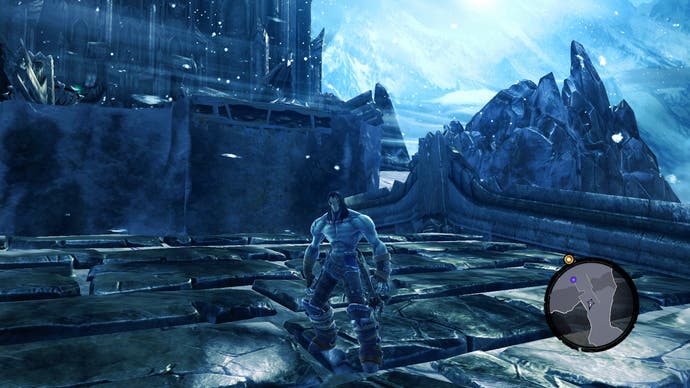

While the omission of any tangible improvements over the console versions is something of a disappointment, the lack of ambition in this regard does have its benefits. Darksiders 2 is a very easy game to run across a range of hardware configurations.
Our own fairly modest Core i5 and GTX460 gaming rig managed to provide us with a locked 60FPS in both 720p and 1080p, while dropping v-sync gave us frame-rates up to 155FPS in 720p, and around 80 to 90FPS at full HD, though at the expense of some truly horrendous screen-tearing. V-sync really is the way to go here. On the £300 Digital Foundry PC, we tested the game at "max settings" at 1366x768 and 1920x1080 and found that the former gave us a silky smooth 60FPS, but the latter saw some wildly variable performance.
On the downside, however, while playing at higher resolutions provides us with much sharper images, the artwork doesn't scale up that well and some of the lower resolution textures often appear even blurrier than on console as a result of being stretched across higher resolution geometry, while shadows often appear horribly pixelated. The extra crispness and reduced aliasing is still a worthy upgrade though, delivering a more visually pleasing experience over the 360 and PS3 releases, with more responsive controls part of this package due to much higher frame-rates being easily attainable.
Darksiders 2: The Digital Foundry Verdict
It's safe to say that Darksiders 2 is a worthy buy on both Xbox 360 and PlayStation 3, with multi-platform aspects well handled, on consoles at least. In fact, outside of a few specific elements, such as the use of higher-resolution textures on the PS3 and additional lighting on the 360, there really is nothing to separate the two games at all.
Performance is also very similar during gameplay, with neither version really commanding a noticeable advantage. Any variances in this area are more likely down to subtle difference in how we played the game, rather than how well each console deals with the rendering load. In that respect we think that Darksiders 2 is worth checking out regardless of which platform you happen to own - both consoles offer up the same core experience with very similar plus and minus points in terms of visual quality.
On the other hand, it's difficult to avoid the feeling that the PC version comes across as a barebones release transplanted from console DNA. The experience is somewhat held back by the console-quality assets, which don't scale up all that well when the game is run in higher resolutions, and the lack of any PC-specific graphical upgrades comes across as something of a disappointment. It is rather pleasing to see that high frame-rates are easily attainable on a number of configurations, even if this is more down to the lack of advanced graphical effects and memory intensive texture work on offer, as opposed to being well optimised for the PC platform. Either way, running the game at 1080p60 easily makes it the best version to get, with smoother gameplay and more responsive controls delivering a tangible edge over the consoles.
